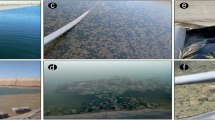Abstract
We examine the ecological aspects concerning the status of the surface waters in the delta of the Selenga river for the low-water conditions which have been observed since 1996. The ongoing changes in the most important indicators of the status of the waters in the river delta are assessed on the basis of results of hydrological, hydrochemical and hydrobiological investigations made by these authors in 2013–2015 and with consideration for earlier research efforts. It is established that the low-water conditions resulted in a decrease of the role of the main delta branches, Kharauz and Levoberezhnaya, in streamflow. An increase in the contribution of groundwater in the alimentation of the river led to an increase in concentrations of main ions: for the current low-water period their total content has varied from 119 to 780 mg/L, with a maximum in small delta branches in the wintertime. Changes in concentrations of biogenic elements were recorded: total phosphorus from 10 to 190 μg P/L, mineral phosphorus from 0 to 35 μg P/L, and nitrate nitrogen from 0.01 to 0.81 μg N/L. A minimum of mineral phosphorus compounds and nitrogen was observed at the time of mass development of algae. It is established that the dynamics of organic matter content is determined by changes in hydraulicity, and by the intensity of phytoplankton development. Within the long-term context, a deterioration of water regime and vegetation infill and swamping of shallow delta branches were recorded. The development level of the phytoplankton and changes in its structure point to a progressive eutrophication of the Selenga waters. According to the value of the saprobic index, the quality of the Selenga waters corresponds largely to the category of “moderately polluted” waters (class II and III), and it decreases at low-water periods, especially in shallow delta branches with a high population of cryptophytic algae, to the category of “polluted” waters.
Similar content being viewed by others
References
Mikhailov, V.N., These Changeable River Deltas, Priroda, 2002, no. 4, pp. 43–49 [in Russian].
Gorbunov, K.V., The Water Bodies of the Volga Delta, Their Configuration, Regime and Evolution, Proc. 1st Conf. on the Study of the Water Bodies of the Volga Basin Volga-1. Problems of Study and Rational Use of Biological Resources of Water Bodies (September 2–8, 1968, Togliatti), N.A. Dzyuban, Ed., Kuibyshev: Kuibyshev. Knizhnoe Izdatel’stvo, 1971, pp. 74–81 [in Russian].
Sorokovikova, L.M., Popovskaya, G.I., Tomberg, I.V., and Bashenkhaeva, N.V., Space and Time Variations in Concentrations of Biogenic and Organic Matter in the Water of the Selenga River and Its Delta Branches, Water Resour., 2009, vol. 36, issue 4, pp. 443–452.
Sinyukovich, V.N., Zharikova, N.G. and Zharikov, V.D., The Selenga River Runoff in the Delta, Geogr. Prir. Resur., 2004, no. 3, pp. 64–69 [in Russian].
Sorokovikova, L.M., Sinyukovich, V.N., Dryukker, V.V., Potemkina, O.G., Netsvetaeva, O.G., and Afanasiev, V.A., Ecological Features of the Selenga River During Flooding, Geogr. Prir. Resur., 1995, no. 4, pp. 64–71 [in Russian].
Sorokovikova, L.M., Tomberg, I.V., and Bashenkhaeva, N.V., Chemical Composition of the Selenga River Waters, and Its Delta Branch, in The Selenga River Delta: A Natural Biofilter and Indicator of the Status of Lake Baikal, Integration Projects of SBRAS, Issue 15, A.K. Tulokhonov and V.M. Plyusnin, Eds., Novosibirsk: Nauka, 2008, pp. 88–101 [in Russian].
Sinyukovich, V.M., Sorokovikova, L.M., Tomberg, I.V., and Tulokhonov, A.K., Climate Changes and the Selenga River Chemical Flow, Doklady Earth Sci., 2010, vol. 433, issue 2, pp. 1127–1131.
Tomberg, I.V., Sorokovikova, L.M., Popovskaya, G.I., Bashenkhaeva, N.V., Sinyukovich, V.N., and Ivanov, V.G., Concentration Dynamics of Biogenic Elements and Phytoplankton at Selenga R. Mouth and in Selenga Shallows (Lake Baikal), Water Resour., 2014, vol. 41, issue 6, pp. 687–695.
Baram, G.I., Vereshchagin, A.L. and Golobokova, L.P., Microcolumn High-Performance Liquid Chromatography With UV Detection for the Determination of Anions in Environmental Materials, J. Anal. Chem., 1999, vol. 54, issue 9, pp. 854–857.
Manual on Chemical Analysis of Surface Waters, L.V. Boeva, Ed., Rostov-on-Don: NOK, 2009, Part 1 [in Russian].
Wetzel, R.G. and Likens, G.E., Limnological Analyses, 2nd Ed., New York: Springer-Verlag, 1991.
Kozhova, O.M. and Mel’nik, N.G., Instructions on Processing of Plankton Samples Using the Counting Method, Irkutsk: Irkutsk Univ., 1978 [in Russian].
Sinyukovich, V.N., The Water balance of the Selenga River Basin, Geogr. Nat. Resour., 2008, vol. 29, issue 1, pp. 54–56.
Popovskaya, G.I. and Tashlykova, N.A., The Phytoplankton of the Selenga River, in The Selenga River Delta: A Natural Biofilter and Indicator of the Status of Lake Baikal, Integration Projects of SB RAS, Issue 15, A.K. Tulokhonov and V.M. Plyusnin, Eds., Novosibirsk: Nauka, 2008, pp. 167–182 [in Russian].
Aibund, M.M., Davtyan, N.A., Sukhodol’skii, A.S., and Fialkov, V.A., Investigating the Dynamics of the Mouths of Rivers and the Delta Portions of Water Bodies; A Case Study of the Selenga River and Lake Baikal, Proc. All-Union Hydrological Congress (October 9–13, 1973, Leningrad), Leningrad: Gidrometeoizdat, 1975, in 11 vols, vol. 5: Hydrology of Lakes, Reservoirs and River Mouths, pp. 356–365 [in Russian].
Henderson-Sellers, B., Engineering Limnology, Boston: Pitman, 1984.
List of Fisheries Normatives: Maximum Allowable Concentrations (MAC) and Approximately Safe Impact Levels (ASIL) of Harmful Substances for the Water of Water Bodies Having a Fisheries Significance, 2010, Moscow: VNIRO [in Russian].
Popovskaya, G.I., Sorokovikova, L.M., Tomberg, I.V., Bashenkhaeva, N.V., and Tashlykova, N.A., Chemical Composition Charactristics of Water and Phytoplankton Development in Lake Zavernyaikha, Geogr. Nat. Resur., 2011, vol. 32, issue 4, pp. 344–349.
Author information
Authors and Affiliations
Corresponding author
Additional information
Original Russian Text © L.M. Sorokovikova, V.N. Sinyukovich, I.V. Tomberg, G.I. Popovskaya, M.S. Chernyshev, V.G. Ivanov, T.V. Khodzhe, 2017, published in Geografiya i Prirodnye Resursy, 2017, Vol. 38, No. 1, pp. 81-89.
Rights and permissions
About this article
Cite this article
Sorokovikova, L.M., Sinyukovich, V.N., Tomberg, I.V. et al. The status of the aquatic ecosystem of the Selenga river delta under long-duration low-water conditions. Geogr. Nat. Resour. 38, 60–67 (2017). https://doi.org/10.1134/S1875372817010085
Received:
Published:
Issue Date:
DOI: https://doi.org/10.1134/S1875372817010085




